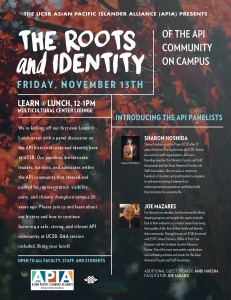The topic of social media and scholarship came up yesterday in the Research Institute of the NASPA Western Regional Conference in Oakland. One of the questions posed was, “who defines a legitimate source of knowledge?” As mentioned yesterday, when speaking with academic administration or faculty, one would probably cite academic journals, not blogs, as they are not seen as scholarly publications. There are certain standards in the academy of what constitutes scholarly writing. I can accept the idea that blogs may not yet be considered scholarly publications but what I will not accept is the idea is not blogs are not legitimate sources of ideas, whether they are considered scholarly or not, especially ideas from those who have been marginalized and whose voices have not been heard.
As one who has felt marginalized throughout my life and career, my blog offers me the voice to be heard. No one interrupts me when I am in the middle of writing a sentence. I write when my mind is free and when I want to. I often write my posts between midnight and three AM. Dr. Larry Roper, the former Provost for Student Affairs at Oregon State, said this when he spoke at UC Santa Barbara years ago, “Please do not steal my pause…the best comes after the pause.” This is a challenge I’ve faced as one who needs the time to think and finds myself being interrupted in mid-sentence when I’m speaking.
Even worse is that some of my ideas are quickly dismissed when I am expressing my perspective that may not align with mainstream thinking because of my upbringing and cultural background. Social media, especially blogging, has allowed me to contribute to the conversations in the field of student affairs, higher education, and technology. It has also provided me the medium to share my shared experience as an Asian-American. Some of the topics I write about resonate with others as I get emails from others who tell me they can relate, including this recent post on my challenge as an Asian American leader and assertiveness.
I don’t apologize for my thoughts, even as they may sound ridiculous to others. Why should I? I have a perspective like everyone else. Whether they are “right” or “wrong” is in the eye of the reader, but they are perspectives nevertheless. I have gotten tired of waiting for others to allow me to speak because I may not have the three letters after my name or because I don’t sit in a high enough position at the university. I think marginalized folks can relate to the frustration of being silenced or dismissed. Blogging has allowed me to contribute my thoughts and express them how I want to. When I blog, I don’t always know how readers will interpret them, and I know there are consequences to my writing. However, what I write are my ideas shaped by my experience and struggles. No one will tell me, nor should they, that my personal truth as the way I only see them is not valid.
When I started blogging, I intended to share my thoughts and considered it a public personal reflection. One of the unexpected outcomes has been collaborating with other student affairs and technology professionals who share common interests with me. I’ve had discussions with others about the current and future of student affairs and how technology should play in how we serve our students. As I’ve discovered during these collaborations, there are other folks like me who have ideas, yet they don’t have the medium to express them. My blog has allowed me to contribute to conversations and connect with others.
If you’ve felt marginalized and your voice silenced – consider blogging. No one’s going to interrupt your thoughts while you’re writing, and yes, there are consequences to what you write, but at least you’re sharing your unique ideas for others to read. Your ideas are too valuable to be kept in your head!
